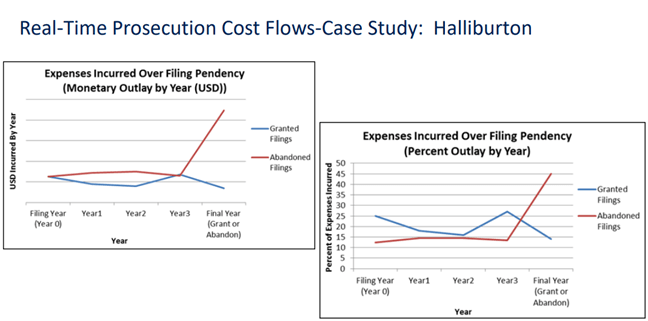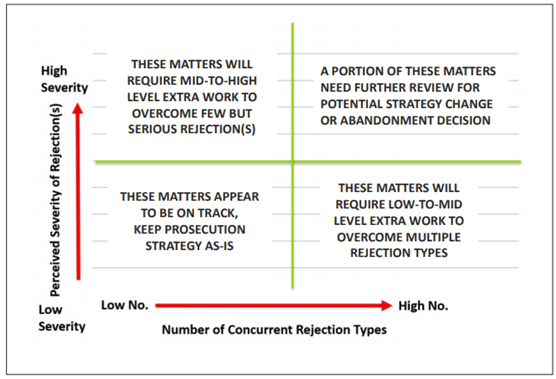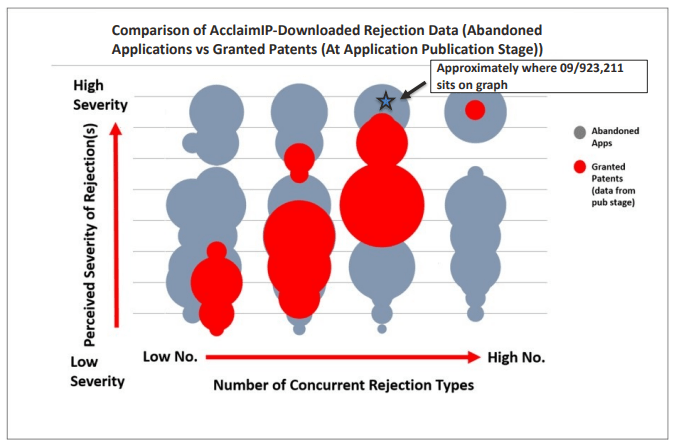Securing a patent is a long, often unclear and costly job in 2021. Courts continue to ask for more disclosure and better claims, while law firm clients demand flat fee billing with their own shrinking corporate budgets. Things get much more difficult when one has a large portfolio to manage across many jurisdictions, all moving through various filing routes. In this article, we focus on how to manage prosecution costs, which is one of the most uncertain parts of the patent attainment process.
If we observe the spend on granted versus abandoned applications across years of examination, the case study below shows costs trending high for abandoned matters in the final year(s) of their prosecution, just before the abandonment decision is finally made (Fig 1: top left chart USD prosecution spend by year, bottom right chart percent spend of total by prosecution year). With prosecution cost modeling, we can change this scenario for problem applications during the examination stage, and forecast on these matters for enhanced decision-making, whether that course of action is to abandon, file a request for continued examination (RCE), or appeal an examiner’s decision.
Framework Development for Prosecution Cost Modeling and Analysis
A framework for prosecution cost modeling can be developed using data-points available on the USPTO website, or from various third-party patent search tools. Our experience in working with large firms has shown that the starting point of such a framework can be in understanding the number of concurrent rejection types received via examiner office actions during prosecution versus the perceived severity of those various rejections (as determined by the filer).
During periodic portfolio review meetings with various stakeholders (R&D or engineering, legal, and business/licensing teams), a four-quadrant prosecution cost modeling matrix (Fig 2) greatly helps one to bucketize their portfolio among high severity rejected matters, those that will likely make it to grant but may need extra help, and matters that look to be on track with current prosecution strategies. This bucketizing therefore helps us recognize sunk costs and potentially allows for cost shifting to more favorable outcomes, freeing up capital that can be used on new filings or other types of intellectual property. While it may look obvious in the matrix, the bottom-left quadrant is where matters are on track, while in the top-right quadrant, there is a higher percentage of abandonment observed in already-dispositioned matters (foretelling that currently prosecuting matters that begin to exhibit this same behavior may be headed towards abandonment as well). The matters in the remaining two quadrants also hold the key to potential cost savings, depending upon attorney/agent time necessary to achieve the client’s desired outcomes. How far into the framework from top-right down to bottom-left (or into other quadrants) one can go with enhanced matter review will depend upon the matter volume to be analyzed and the bandwidth (time, expertise, hidden costs) of the entire review team dedicated to taking a second look at these items.
One of the analyses conducted in this case study using AcclaimIP-downloaded rejection data of abandoned applications versus granted patents, we observed the results graphed in Fig 3 below. Here bubble size denotes the volume of studied matters that scored similarly, while horizontal placement was determined by rejection type co-occurrence. Vertical placement on the graph was dictated by filer-perceived severity of concurrent rejection types, and by the overall volume of individual types of rejecting references incurred by each matter studied via received examiner office actions.
Looking at the example of filing 09/923,211 (Fig 3), we observed that just before this matter’s third prosecution year the prosecution severity level resulting from a received office action had gone very high, and had abandonment of the matter been undertaken at that time (rather than continuing on for two more years), we could have saved a significant amount of money. Comparing the ‘211 filing with another application (11/323,323 that was immediately abandoned in prosecution year two following a particularly severe office action), we observed a cost savings of 37% for the ‘323 application when compared to the total costs associated with the ‘211 application. Note in Fig 3 that the model placed the ‘211 matter into the top-right quadrant, where enhanced review for potential abandonment should have been undertaken by this matter’s key decision-makers.
Conclusion
In conclusion, as observed above, we can develop a framework for prosecution behavior with patent office data available to us, allowing us to hold regular portfolio meetings with various stakeholders where meaningful matter analysis can be undertaken, potentially resulting in significant prosecution cost savings.
More About AcclaimIP
AcclaimIP makes available a mirror image of the entire USPTO Public PAIR database, updated each and every week. With this comprehensive dataset and its timeliness, users now have the ability to make decisions on prosecuting matters in real time, with the potential to save serious amounts of money, all while creating a high-quality patent portfolio.
AcclaimIP’s Reverse Rejection feature takes the Public PAIR data one step further. Currently prosecuting matters that have received an examiner office action containing any of the four types of rejections will have those rejection types teased out, with the rejecting references available for searching and cross-referencing. This data-flagging, combined with AcclaimIP’s superior timeliness, makes it possible for users to build models around real-time data, allowing them to now make important decisions on matters that may be exhibiting problems. These problem applications can be highlighted for enhanced decision-making, whether that course of action is to abandon, file an RCE or appeal an examiner’s decision. Being able to flag these matters and give them up-front priority will result in cost savings by giving practitioners ways to avoid costly hours spent on “losing” decision pathways.
Further Reading






